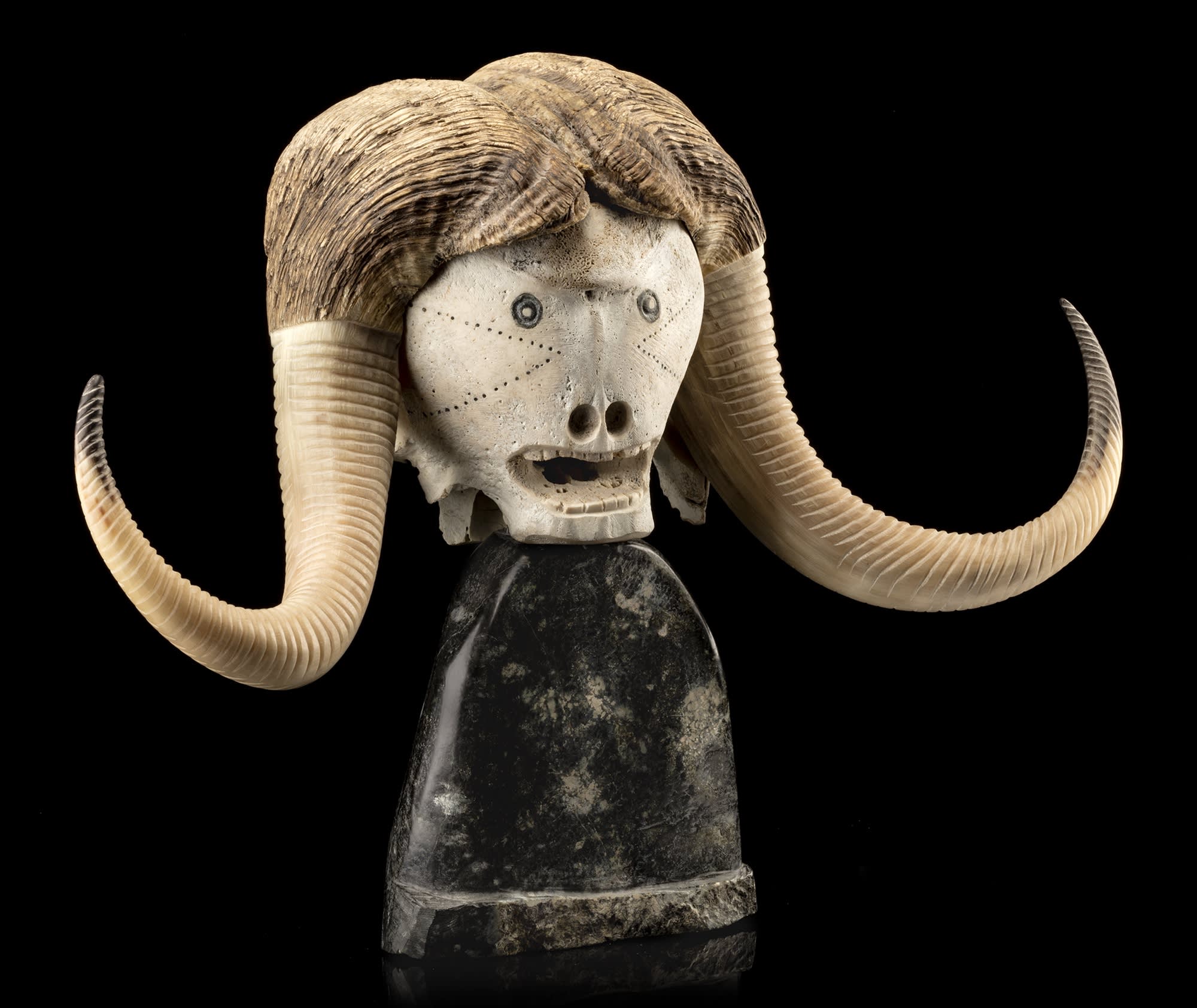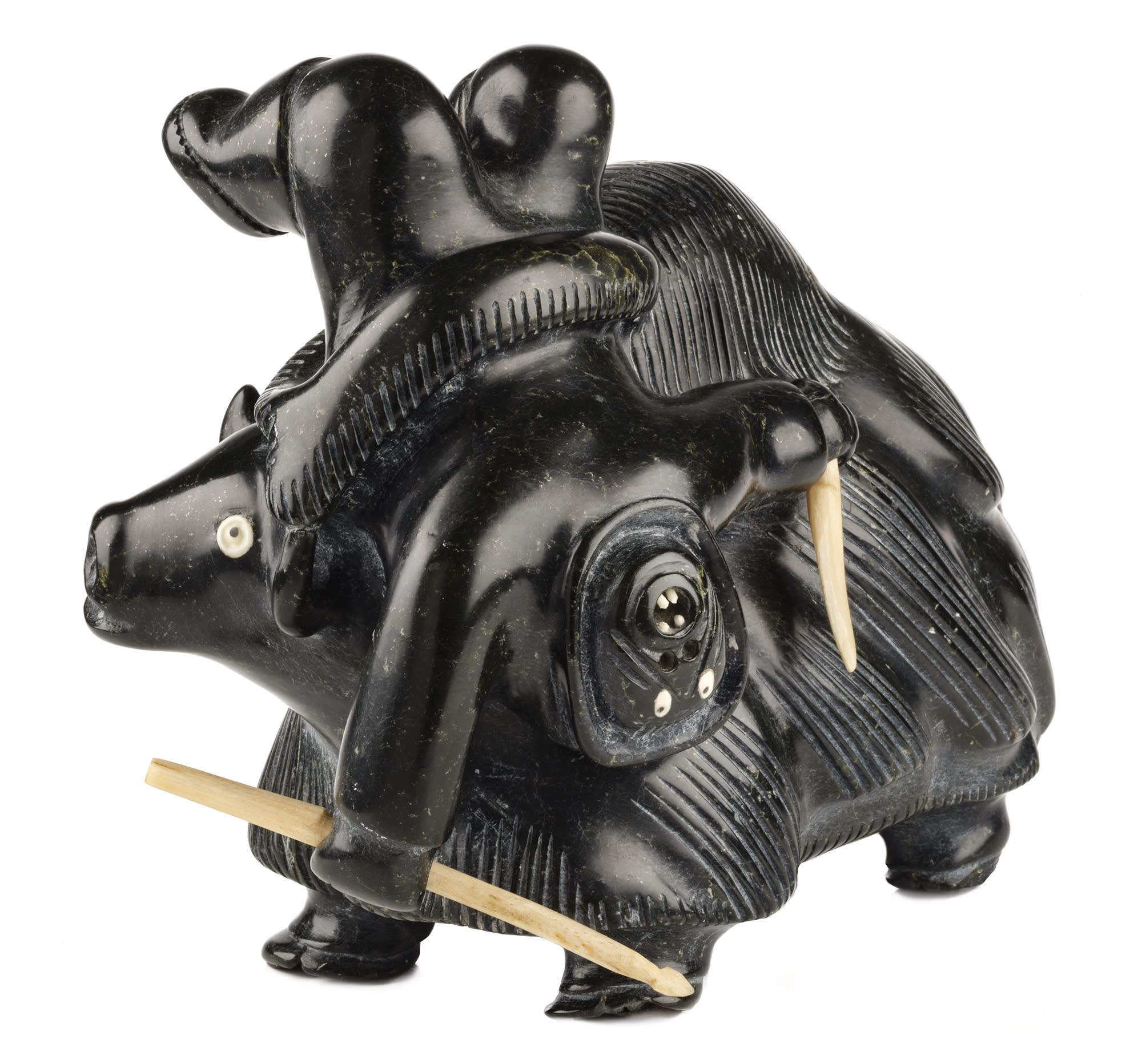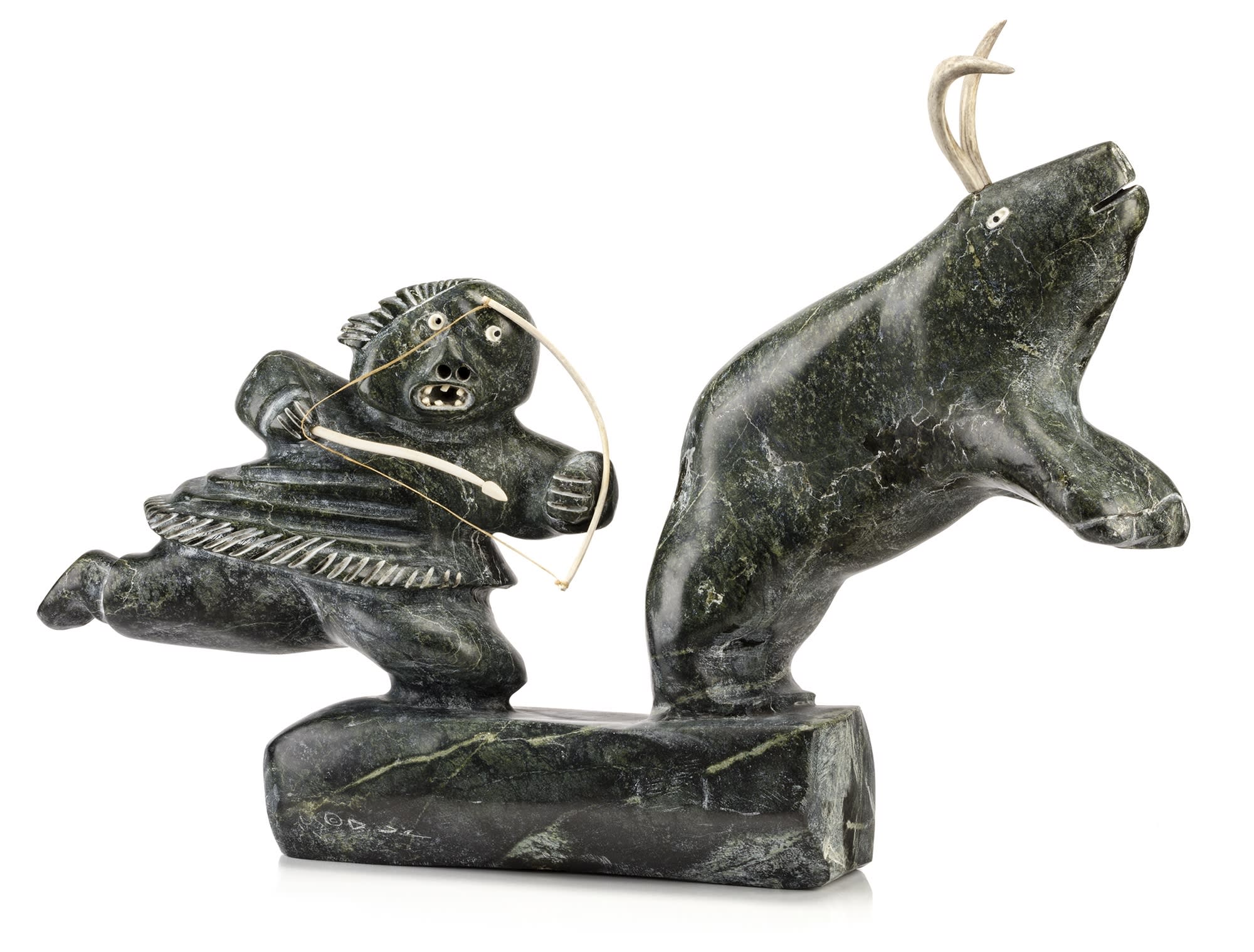I had the great pleasure and privilege to meet Judas Ullulaq a few times in the 1990s, during the last decade of his life; a couple of times in his home community of Gjoa Haven and once in Verona, Italy of all places, where he and Joseph Shuqslak attended the opening and demonstrated carving at the Immaginario Inuit exhibition in 1995. I’m not sure I’ve ever met anyone with a more infectious smile and positive attitude to life and work than Ullulaq. His approach to artmaking is nicely summed up by his comments in an interview conducted by Simeonie Kunnuk in 1994 and published in the Inuit Art Quarterly (Vol. 10, No. 2, Summer 1995:14-22):
I am always carving—all day, every day. I don’t exert myself, but I work at it steadily. As long as I am well, I am usually carving. I have my children, and I am not hungry. I become bored if I stop carving and do nothing. So carving is a part of my everyday life. I just carve happily every day, enjoying my time.
It’s always a pleasure to meet someone who truly loves their work. When that person is an artist, it is wonderful to witness how that love enriches the lives of countless others. It is not only Ullulaq’s smile that was infectious; his sculptures have brought smiles and laughter (and sometimes tears) to art lovers around the world. It is well nigh impossible not to be amused or otherwise charmed by his creations.
Each one of the three works on offer this Fall is impressive and engrossing in its own way. We hope that you will experience in them some of the joy that Ullulaq so obviously felt in carving them. It has certainly been our pleasure to have them live with us for a time.
Ingo Hessel

Lot 116
JUDAS ULLULAQ (1937 - 1999) UQSUQTUUQ (GJOA HAVEN)
Muskox Shaman, 1998
muskox horns and skull, stone, string, and black inlay, 17.5 x 24.5 x 9.5 in (44.5 x 62.2 x 24.1cm)
ESTIMATE: $20,000 — $30,000
Judas Ullulaq famously carved in both stone and whale bone to produce sculptures with a variety of themes and subjects. Muskoxen were favourite subjects: as single figures, in hunting scenes (see Lot 123), and in shamanic imagery. Muskox horn was also one of his favoured materials; Ullulaq used it as inlay or to fashion weapons and implements, but he also incorporated single horns or even full sets of two in large-scale compositions. [1] In a handful of works the artist invented a particularly daring compositional format in which he made use of a full set of horns still attached to part of the animal’s skull. A fine example of this is the marvelous Muskox Shaman with Spirit Helper from c. 1988-90, sold at auction by First Arts (13 July 2021, Lot 24).
In the present Muskox Shaman, Ullulaq takes his inventiveness to a new level by manipulating a set of old horns and skull (which he would have found on the land). By reorienting the position of the skull itself and re-attaching the horns, he has managed to free up a flat section on which to create the mesmerizing, skull-like face of a tattooed shaman. Ullulaq has meticulously carved ridged rings into the horns, transforming them into braids. These, together with the facial tattoos, identify this formidable shaman as a woman.
Ullulaq’s love of texture and contrast is well-known and is on full display here. We love the way that both the colour and texture of the carved horn ridges contrast with the natural striations at the base of the horns (the “boss” – which itself looks like hair). The face brings a further change in colour and texture. The stone base (which looks dress-like) turns the sculpture almost into a full female figure. And finally, the back of the head – intentionally, we are certain – presents another, seriously spooky face.
Muskox Shaman is one of Ullulaq’s most brilliant inventions – one that manages to be incredibly eerie and genuinely lovely at the same time. It’s a powerful, stirring work of art. Astounding.
1. See the section on Judas Ullulaq in Darlene Coward Wight, Art & Expression of the Netsilik (Winnipeg Art Gallery, 2000), pp. 152-171 –in particular, cats. 148, 154, 157.

Lot 123
JUDAS ULLULAQ (1937 - 1999) UQSUQTUUQ (GJOA HAVEN)
Hunter Tossed by Muskox , c. 1988
stone, antler, and muskox horn, 7.25 x 10.5 x 5.5 in (18.4 x 26.7 x 14cm)
ESTIMATE: $7,000 — $10,000
The caption for this sculpture in Darlene Wight’s Art & Expression of the Netsilik exhibition catalogue is based on interviews she held with Ullulaq in 1997. It turns out that the story behind this captivating image is as remarkable as the work itself:
Ullulaq remembered his grandfather who was a very determined hunter. Before there were guns, his grandfather would go right up to a muskox, in front of its nose. On more than one occasion, he was lifted up in the air on its horns. Then he would kill the muskox with his spear. [p. 160]
Hats off to Ullulaq’s grandfather for his chutzpah and courage, and kudos to the artist for creating one of his most engaging and brilliant compositions. Masterfully conceived and executed, Muskox Tossing Hunter is a tour de force sculpture brimming with dynamism and humour. Both the hunter and muskox are portrayed as
angst-filled (as it turns out they should be), even if it seems for the moment that the animal has the upper hand. We are especially impressed with Ullulaq’s unusual treatment of the muskox’s fur. First, the artist sculpts the fur into beautiful overlapping swathes, then applies his trademark parallel lines as texture. The
resulting patterns add a feeling of turbulence to what is already a highly dramatic composition. Wow.

Lot 147
JUDAS ULLULAQ (1937 - 1999) UQSUQTUUQ (GJOA HAVEN)
Man Chasing Caribou , early 1990s
stone and antler, 21.5 x 30.5 x 6 in (54.6 x 77.5x x15.2 cm)
ESTIMATE: $12,000 — $18,000
Ullulaq’s zest for life, his sense of humour, and his inventiveness shine through in his art and never fail to delight and impress us. Hunter Chasing a Caribou is one of the most charming examples of his hunting scenes – not to mention one of the largest. Carved from a single chunk of stone, the sculpture is massive yet interestingly balanced, with hunter and caribou cantilevered out to either side, giving the work lots of open space and a pleasing outline. It reminds us of his Murder Scene of 1988, which is similarly balanced, on a smaller base. [1]
The sculpture has a great sense of movement as well; we feel the tension of the chase in the extended limbs of both figures. In reality, the two are probably farther apart than shown, but their proximity adds to our suspense. The hunter is certainly excited, and perhaps exhausted as well, as he races after his prey. For its part, the caribou is apparently nimbler than it looks and might be about to leap into the water to make its escape. Deciding who to root for is a tough choice for viewers of scenes like this by Ullulaq. He has a knack for investing both his human and animal subjects with real personality.
1. Illustrated in Darlene Coward Wight, Art & Expression of the Netsilik (Winnipeg Art Gallery, 2000), cat. 155, p. 159.
